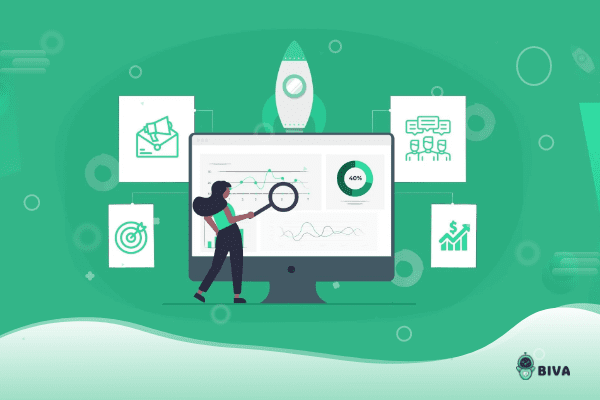

In our previous article, we have seen the list of important aspects one should focus on during the pre-launch stage of a new product.
However, once the product launch happens, it is crucial to monitor certain aspects (say campaign performance, target audiences’ browsing, and purchase behavior) as the launch progresses, to identify what’s working, what is not working, and tweak them accordingly to achieve better results.
Here we discuss them in detail.
Monitor Marketing’s Launch Efforts:
The success of a product launch is just as much about attracting users to try the product as it is about the product itself, which means measuring the performance of marketing efforts is a necessary starting point.
Monitor the campaign and channel performance by looking at metrics like click-through rate (CTR) and bounce rate. This gives insights into the effectiveness of positioning and promoting the new product.
- Click-through rate tells the quantity of traffic the campaign is driving to the website. A high click-through rate shows the ad is driving more traffic to the website. Whereas, if the ad is getting more impressions but not clicks, it is time to halt the campaign and revise it as the ad is not appealing enough to motivate viewers to take the next step.
- Bounce rate talks about the quality of traffic the ad is driving to the website. An extremely high (>70%) or extremely low bounce rate (<25%) could mean broken links, and one needs to fix those links immediately. Whereas bounce rate over 50% means mismatch in expectations – the keywords used for targeting are not in line with the content of the page and one can overcome this issue by optimizing the keywords.
Also, track social and web mentions to know how well the people are engaging with the content and responding to the messages. Do sentiment analysis to see whether the overall responses are positive or negative.
Monitor User Engagement on the Website:
A solid, well-executed marketing campaign can drive traffic to the website, but it cannot control what happens next. After the marketing blitz and buzz, the challenge rests in keeping users around and interesting them to come back. That is why in the early days of product launch, it is critical to focus on the user’s experience and engagement once they are on the website.
Monitor user engagement by tracking metrics like landing page visits, average time on page, actions they are taking/ features they are using. All this information helps in optimizing the landing pages to sustain the user’s interest and increase engagement.
- Average time on the landing page helps in determining how valuable the page content is to the target audiences. The more time the users spend on the page, the higher their chances of converting. If the average time on the page is low, consider improving landing page content (high-quality images), adding more interactive elements, or other features (testimonials) that may help boost engagement.
- What users do and where they navigate within the product is a great indicator of the value they are getting. Track the usage of various product features to prioritize those that are most important to users and potentially remove or de-prioritize features that are not used.
Along with measuring marketing launch efforts and user engagement, it is important to perform the below actions to not only sustain the momentum of the product launch but also to have a long-term impact.
Triggered Emails: Have triggered emails in place to send to customers based on the actions they take. One can be an order confirmation email that thanks customers who made a purchase and has the information about the delivery (products purchased, arrival date, shipping address, tracking information, etc.,). Another can be a cart abandonment email to remind visitors who left mid-purchase and encourage them to complete placing the order. The other set of emails can be product review (to collect feedback on the products purchased) and recommendations (suggesting complementary or higher-end products)
Retargeting Campaigns: Use tracking pixels to re-target potential customers that discontinued a purchase based on their site activity. One can do retargeting campaigns on Google Ads, Social Media Platforms (Facebook Dynamic Ads, LinkedIn Ads), and other retargeting advertising platforms.
Real-Time Information: Dynamically display the messages related to the availability of product variants and the time it takes for delivery on the landing pages. For example, if a particular product variant goes out-of-stock on the 2nd day of a 10-day campaign, flash the message saying the brand is restocking and customers can pre-order with a slightly longer delivery window. That way, one does not lose the prospects because of the unavailability of the product they are interested in, and the brand has also successfully served the entirety of their audience.
Consistent Communication: Provide consistent and up-to-date, on-brand communications across multiple touchpoints (email, social media, contact center) regardless of where they are in the path to purchase. This helps in creating the same impression and experience of brand/product across channels. Also, adjust the number of touchpoints according to where a prospective user comes across the product, to avoid information overload.
Optimized Ad Spend: Dynamically re-allocate ad-spend across marketing channels and campaigns based on their monitored performance in achieving the end goal (number of clicks, overall conversions). For example, if certain keywords are costing a lot of money and not generating any leads, change the bidding strategy and target those keywords which are generating high CTRs or conversions. Similarly, if campaigns running at a certain time of the day or on certain days of the week are performing better, maximize the spending during those periods and minimize it during the rest of the periods.
Conclusion:
Pulling off a successful product launch is not an easy feat. But, once the product is out of the door and into the world, it is important to be cognizant of which efforts are effective (or not), so that one can make changes accordingly.
Retailers can take cues from the above discussion, keep a very close eye on the campaign metrics and user behavior, and tweak them to make the most of the new product launch as it progresses.
Related Posts
Marketing Ideas
Product Foundations


